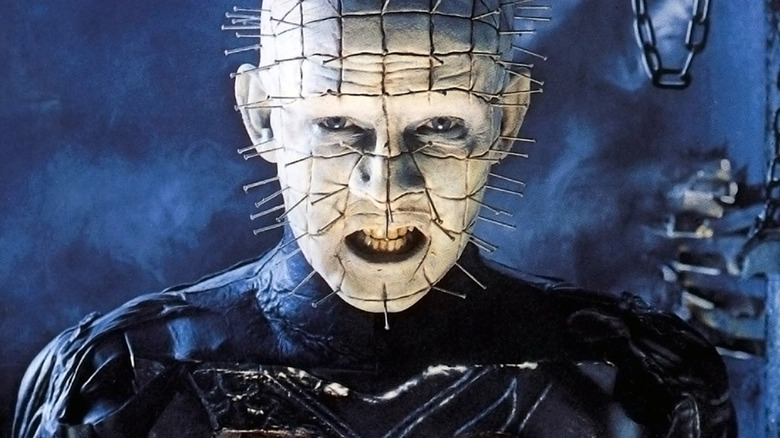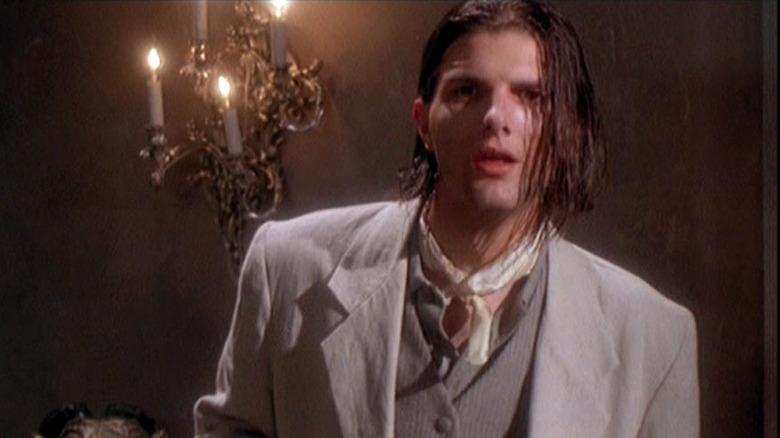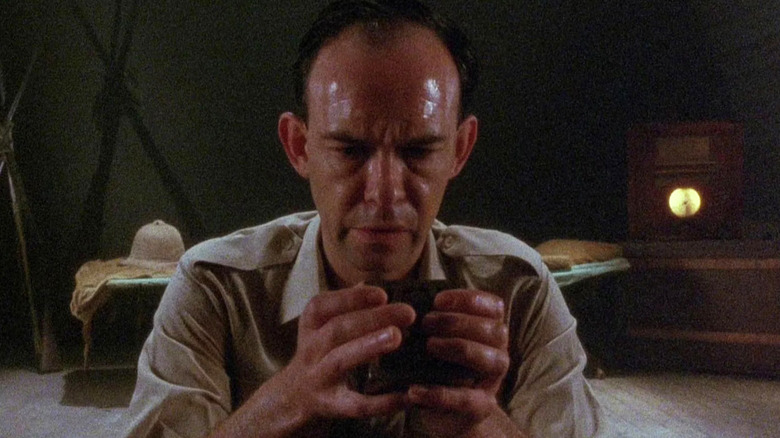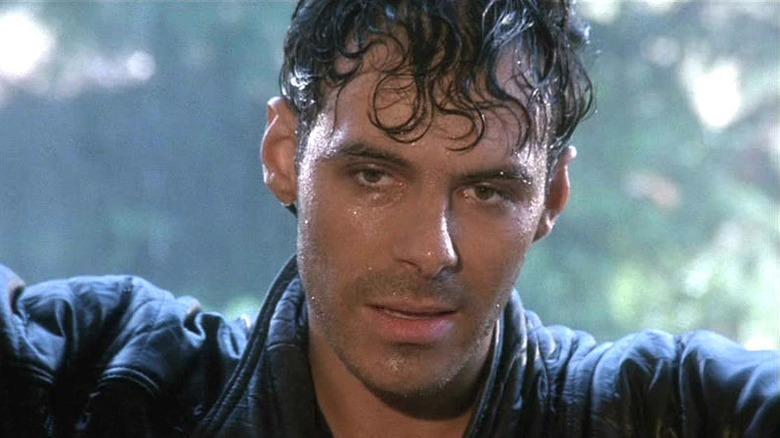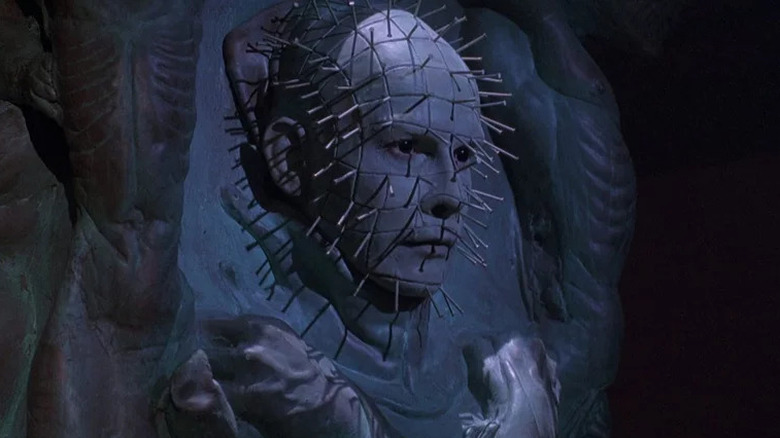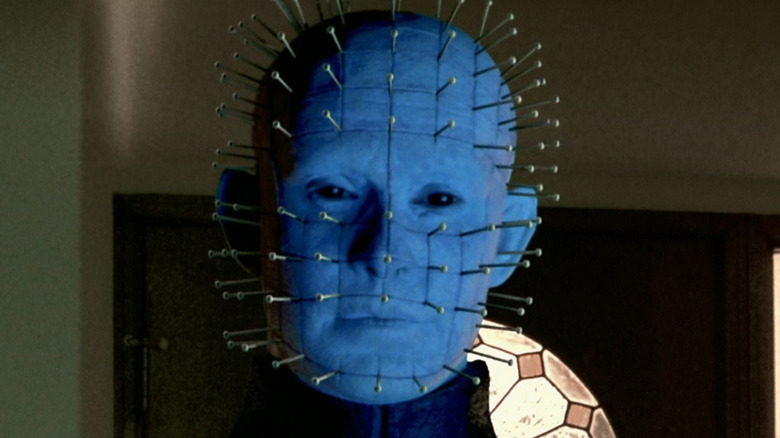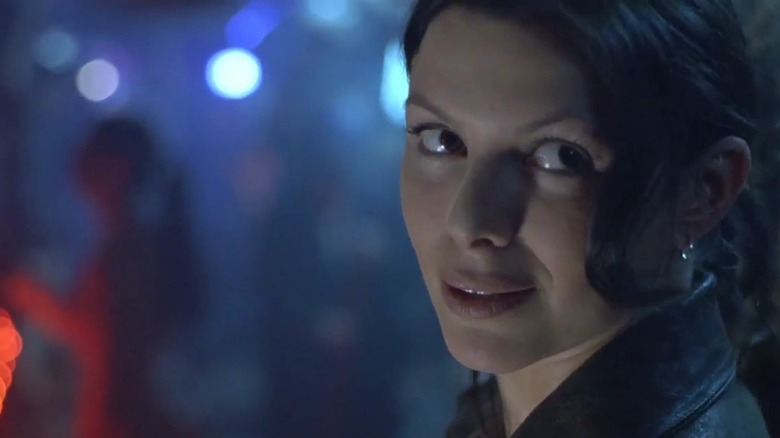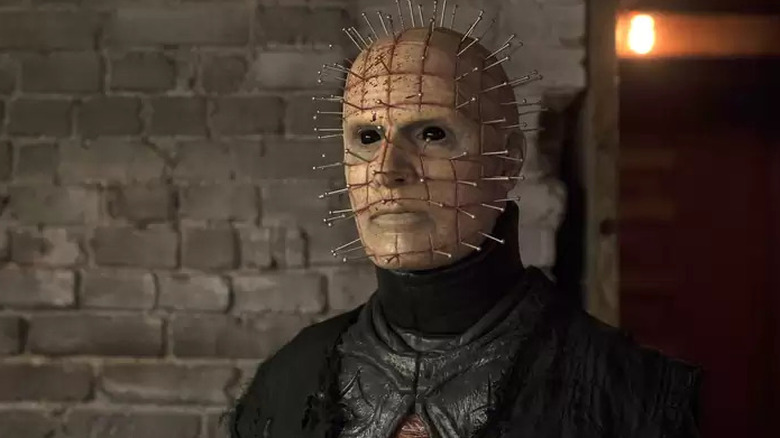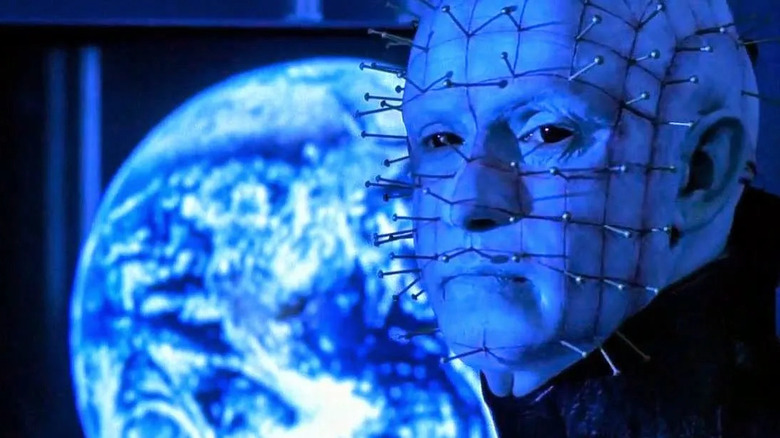The Entire Hellraiser Timeline Explained
"We have such sights to show you." For anyone who's seen the "Hellraiser" films, these six words are shiver-inducing. That's appropriate given the franchise's themes. Since 1987, Clive Barker and creatives inspired by him have explored the alluring and terrifying line between pain and pleasure, then what happens when it disappears. Because "Hellraiser" is a horror franchise, that line vanishes for and through the Cenobites, a race of extra-dimensional sadomasochists whose leader is a once British Army World War I commander now named, for obvious reasons pictured above, Pinhead (the legendary Doug Bradley).
If that last sentence doesn't make it abundantly clear, the "Hellraiser" timeline is as labyrinthian as the Lament Configuration that summons multiple evils. With David Bruckner's excellent 2022 "Hellraiser" inviting a new generation to the franchise, that chronology is worth sifting through and digesting.
The ever-expanding history of the Cenobites' interactions with humanity makes it clear that the tug of war between both pleasure and pain and vice and virtue are archetypally human, occurring in the realm of the mind as often as Hell itself, or Hell/Heaven on Earth (remember: the Cenobites are demons to some and angels to others). There is almost no limit to where, or when, the "Hellraiser" films will go. Here is the entire "Hellraiser" timeline explained.
In 1796, Lemarchand creates the Lament Configuration (Hellraiser: Bloodline)
The "Hellraiser" franchise begins, chronologically, in the most unlikely of places — late 18th century France. You wouldn't think a decades-simmering Revolution and just-beginning army campaign from Napolean would be the backdrop for kinky and possibly demonic creatures, but you'd be wrong.
In 1796, a renowned toymaker named Phillip Lemarchand (Bruce Ramsey) is commissioned by wealthy aristocrat Duc de L'Isle (Mickey Cottrell) to make a puzzle box according to L'Isle's exact specifications. Since Lemarchand is meticulous and excellent at his craft, he does so impeccably. And because this is the "Hellraiser" franchise, L'Isle's specifications yield a device that opens a portal to Hell. When Lemarchand witnesses his creation rip a gateway between Earth and the netherworld, he dashes home to create a device that will counteract his first. These dual devices are the Lament Configuration and Elysium Configuration, respectively.
Before Lemarchand can assemble his antidotal box, however, he is killed by L'Isle's assistant Jacques (Adam Scott), who eerily informs him that the entire Lemarchand bloodline is cursed for giving Hell a gateway to Earth-realm. These are arguably the most important events in "Hellraiser" history. The Lament Configuration fuels the story of almost every film in the franchise and catalyzes the 1987 original. It also sets up events that occur in 1996 and 2127. But it's not the only crucial event that occurs in Europe centuries before "Hellraiser" takes place.
During World War I, Captain Elliot Spencer becomes Pinhead (Hellbound: Hellraiser II, Hellraiser III: Hell on Earth)
There is zero question that Doug Bradley's Pinhead was the breakout character of 1987's "Hellraiser." So there's little surprise that the second "Hellraiser" promptly answered any questions audiences had about his origins, which shockingly trace back to World War I.
Following a recap of the first film's phantasmagoric and splatter-filled conclusion, "Hellbound: Hellraiser II" opens in a British military bunker. There, Elliot Spencer (also Doug Bradley), an officer dressed in his standard-issue khakis, toys with Lemarchand's Lament Configuration. The box snaps into place with a rush of electricity and Pinhead is born (the chains which spring from the box to vivisect Spencer before filling his head with nails are peak-Clive Barker). Additional context for this scene comes during "Hellraiser III: Hell on Earth," when it's revealed that Spencer survived the Battle of Flanders and subsequently lost his faith in God and humanity.
That bleak mindset — and, conceivably, the need to feel alive again — lead him to India and the Lament Configuration. This is arguably the most ingenious addition to the "Hellraiser" mythology. If the Cenobites represent what happens when the line between pain and pleasure vanishes, Spencer is an example of the dynamic humanity tragically endures too often. His pain runs so deep that pleasure is the only recompense. It's hard to witness, but it's all too understandable.
Frank Cotton buys the Lament Configuration (Hellraiser)
As viewers of the first "Hellraiser" know, the Cenobites certainly got their hooks into Frank Cotton. We meet Frank in 1987, 59 years after the end of World War I. While on vacation in Morocco, the hedonistic Frank purchases the Lament Configuration from a salesman who swears it opens a schism to another world of exquisite pleasures. Needing to know if this is true, Frank heads home to his attic to find out for himself. Suffice it to say, Frank experiences what only a few would call "pleasurable."
There aren't a tremendous amount of time and place signifiers in "Hellraiser," more than likely due to budgetary restrictions. That said, it's worth knowing that the 1970s and '80s factor explicitly or implicitly into the film's creation. Speaking to The Guardian in 2017, Clive Barker admitted he had "worked as a hustler in the 1970s ... [And] the way [people] acted — and the way I did, to be honest — was a source of inspiration later. Sex is a great leveller. It made me want to tell a story about good and evil in which sexuality was the connective tissue."
So despite the way the "Hellraiser" saga jumps across centuries, the '80s (a decade marked most notably by its excesses) is an ideal starting place for the franchise's first entry. It's also the setting of its equally twisted sequel.
Kirsty enters the care of Dr. Channard (Hellbound: Hellraiser II)
The state of mental healthcare in the United States has rarely been good, but it was particularly hellish in the 1980s. At the start of the decade, Jimmy Carter signed the Mental Health Systems Act to institute stronger psychiatric welfare policies at the federal level. One year later, Ronald Reagan repealed his efforts with the Omnibus Budget Reconciliation Act, a bill that pushed mental health expenditures right back down to the states. The result? A massive disparity in available care for those suffering. It's little wonder that psychiatric hospitals were a memorable setting for 1980s horror movies ("A Nightmare on Elm Street 3, "Doom Asylum"), and that proved true in "Hellbound: Hellraiser II" as well.
Taking place immediately after the end of "Hellraiser," Tony Randel's follow-up to Clive Barker's landmark film finds Kirsty Cotton (Ashley Laurence) waking in a psychiatric hospital run by Dr. Phillip Channard (Kenneth Cranham). It, like many hospitals in the '80s, is no safe haven. Channard uses Kirsty's recounting of events to resurrect Julia (Clare Higgins), who died during the first "Hellraiser." He also employs another patient named Tiffany (Imogen Boorman) to solve the Lament Configuration.
Memorable imagery ensues (including the now meme-able shot of Frank Cotton next to "I AM IN HELL HELP ME" scrawled in blood), and, most crucially, Pinhead remembers he was once Elliot Spencer during the film's confrontation before becoming trapped in a pillar of souls. Tiffany and Kirsty then escape Dr. Channard and the Cenobites' clutches, though it isn't the last fans see of either of them.
Pinhead escapes the Pillar of Souls (Hellraiser III: Hell on Earth)
"Hellraiser III: Hell on Earth" is arguably the franchise at its most humane. That isn't a word you'd normally think of for a franchise that features sadomasochism and exploding bodies, but Pinhead is literally put in touch with — and then separated from — his human form for much of Anthony Hickox's movie.
When Pinhead learns he was once Captain Elliot Spencer, his personality is cleaved in two. Spencer winds up in limbo and Pinhead is revealed to be a manifestation of Spencer's id. While that makes the mythology of "Hellraiser" infinitely more confusing, it's also a crucial addition in two senses. First and foremost, anchoring the primary antagonist of a horror series about pain and pleasure to one person's most primitive and instinctive personality elements is incredibly clever. As importantly, it allows the "Hellraiser" films to become more psychologically driven, which they do imminently.
Before that, though, Pinhead must escape the Pillar of Souls he got trapped in during "Hellraiser II." He gets a hand from New York nightclub owner J.P. Monroe (Kevin Bernhardt), who purchases the Pillar of Souls for his seedy Manhattan party pad. Naturally, Pinhead feasts on many humans before breaking free and causing chaos. He is defeated by television reporter Joey Summerskill (Terry Farrell) with an assist from, that's right, Elliot Spencer's ghost. The Lament Configuration is buried in the cement foundation of a yet-to-be-constructed building. That turns out to be a massive mistake.
Angelique retrieves the Lament Configuration (Hellraiser: Bloodline)
Remember how the "Hellraiser" timeline technically begins with "Hellraiser: Bloodline?" Spoiler alert: it continues with it and, eventually, ends with it. The fourth entry in the Clive Barker-created cinematic franchise might be the most expansive and ludicrous one ever, and this is a canon of movies that began with exsanguination via extra-dimensional and demonic chains.
It turns out that the building Joey hid the Lament Configuration in was designed by John Merchant (Bruce Ramsay), a descendant of the device's original architect Phillip Lemarchand. That coincidence allows Angelique (Valentina Vargas) — last seen killing Phillip in 18th-century France — to locate the device in 1996. Additionally, it turns out John has been trying to build the Elysium Configuration Phillip designed way back when. Angelique resurrects Pinhead and the two conspire to twist Merchant's plans to their means.
The Elysium Configuration, if utilized correctly, could keep a doorway to Hell open forever. This would allow Hell to actually occur on Earth (or, in the parlance of the first film, for the line between pain and pleasure to vanish permanently), so the duo press John quite relentlessly. He refuses, gets decapitated, and his wife Bobbi (Kim Myers) sends Pinhead and Angelique, yes, back to Hell. This isn't the strangest or most complicated part of "Hellraiser: Bloodline." Before discussing that, though, the franchise scales its horrors down significantly.
Detective Thorne finds the Lament Configuration (Hellraiser: Inferno)
"Hellraiser: Inferno" followed "Hellraiser: Bloodline" by doing almost everything "Bloodline" didn't. "Inferno" released direct-to-video; "Bloodline" dropped in theaters. The latter takes place in three different centuries. "Inferno," as it turns out, takes place almost entirely in the Cenobites' realm or its protagonist's tortured mind. Where the franchise had established a gory and gaudy visual language all its own through its first four entries, the fifth drew from David Lynch and "Jacob's Ladder," too. It worked. "Hellraiser: Inferno" is the most underrated entry in the long-running series, and it should surprise no one that its director, Scott Derrickson, went on to make many wonderful movies.
Where the "Hellraiser" timeline is concerned, however, very little happens in "Inferno." Joseph Thorne (Craig Sheffer), a drug-abusing police detective, finds the Lament Configuration at the site of a grisly murder. He takes it home and, as is revealed in the film's third act, immediately heads to the Cenobite realm. What audiences witness is Pinhead torturing Thorne psychologically, punishing him for his sins, and forcing him to suffer in the realm forever. The film almost feels like a stand-alone entry, but classic "Hellraiser" characters are just on the horizon.
If you or anyone you know needs help with addiction issues, help is available. Visit the Substance Abuse and Mental Health Services Administration website or contact SAMHSA's National Helpline at 1-800-662-HELP (4357).
Kirsty reacquires the Lament Configuration (Hellraiser: Hellseeker)
"Hellraiser: Hellseeker" is not a return to form for the "Hellraiser" series, but it does get the timeline back in order. Kirsty Cotton (Ashley Laurence) is back and, through a series of ridiculous machinations involving an awful husband named Trevor (Dean Winters) back in Pinhead's clutches. This time around, however, Kirsty is as much a wronged heroine as a final girl. What appears to be a film about Trevor suffering sinister hallucinations and people around him dying after Kirsty dies in a car crash with him is actually the story of Kirsty saving her own soul.
Trevor, it turns out, is an adulterer who knows Kirsty's family has untold amounts of wealth (specifically Larry and Frank, from the first "Hellraiser" film). So, Trevor conspires to end Kirsty's life by making her reopen the Lament Configuration and then inherit her mortal possessions. When Kirsty comes face-to-face with Pinhead in the wake of Trevor's machinations, however, she cuts an ingenious deal with the Cenobite. She'll give him five souls in exchange for hers. Pinhead accepts. As it turns out, every death in "Hellraiser: Inferno" is Kirsty earning her resurrection. The deal stands, Trevor is locked in the Cenobites' realm forever, and Kirsty walks away with the Lament Configuration in her possession.
The Lemarchands acquire the Lament Configuration (Hellraiser: Deader)
The next events in the "Hellraiser" franchise are so convoluted, so frequently tacked on to pre-existing spec scripts, that Clive Barker didn't even sanction them. If you've ever thought "I bet I could write a movie," the next few "Hellraiser" entries will embolden that belief. (You can do better than "Hellraiser: Deader.") You, for example, would probably never title a movie "Hellraiser: Deader." And the plot of "Hellraiser: Deader" is one ridiculous decision after another.
Let's start with the biggest one: The Lemarchand descendants have started a death cult. They've gone from high-profile architecture to ritualistic murder and reanimation. When reporter Amy Klein (Kari Wuhrer) heads to Bucharest to investigate their actions, she discovers a corpse holding the Lemont Configuration, opens it, and brings Pinhead back to the mortal realm.
Pinhead resents the cult for thinking they can raise or control him at will, so he slaughters them before Amy sacrifices herself to send Pinhead back to Hell herself. The movie ends with an unnamed reporter investigating Amy's death and finding the Lemont Configuration, suggesting a cycle that's going to begin again. It isn't; instead, another wild pivot is inbound.
A Hellraiser video game leads to the summoning of Pinhead (Hellraiser: Hellworld)
"Hellraiser: Hellworld" joins the ranks of "later entries in a long-running horror franchise that surprisingly takes place in the real world." Some of these films are successful (think "Wes Craven's New Nightmare") while others are less successful, to put it lightly. "Hellraiser: Hellworld," sadly, isn't very good at all.
The premise isn't objectively awful, though. The film is about a group of teenagers who are obsessed with a game called "Hellworld" that is based on the "Hellraiser" movies. One of them, Adam (Stelian Urian), dies by suicide, and 10 years later his still-mourning pals are invited to a "Hellworld" themed party by a mysterious host (Lance Henriksen). The host — plot twist! — is Adam's father, and he stalks and takes his revenge on the friends for much of the film.
If that was where "Hellraiser: Hellworld" ended, it would be dull but fine. However, in the movie's third act it's revealed that the Lemont Configuration was in Adam's possession when he passed. The host finds it, opens it, and summons Pinhead promptly. He and some Cenobites savage the host, and what is or isn't the real world is now entirely unclear.
If you or anyone you know is having suicidal thoughts, please call the National Suicide Prevention Lifeline by dialing 988 or by calling 1-800-273-TALK (8255).
The Lemont Configuration winds up in Mexico and God punishes Pinhead (Hellraiser: Revelations, Hellraiser: Judgment)
The next two entries in the franchise don't make the timeline much clearer. In "Hellraiser: Revelations," the Lemont Configuration winds up in Mexico (with no mention of or ties to the characters from "Hellraiser: Hellworld") and Pinhead tortures those that summoned him. The less said about this film, the better. "Hellraiser: Revelations" was the first film in which Doug Bradley didn't play Pinhead (the duty fell to Stephan Smith Collins). According to Bloody Disgusting, The Weinstein Company made "Hellraiser: Revelations" solely so it could retain the franchise's rights. The entire film was shot in two weeks, and that's clear from moment one.
"Hellraiser: Judgment" is intended as a follow-up to "Revelations" (it shares writer Gary J. Tunnicliffe), but its mythology contradicts Clive Barker's. In "Judgment," God punishes Pinhead and strips him of his powers. That action seems to fly in the face of the fact that the Cenobites were extra-dimensional creatures whose actions were interpreted as "angelic to some and demonic to others." The line between pain and pleasure is not only solidified in "Hellraiser: Judgment" — Heaven and Hell are on opposite sides of it.
It's worth thinking of these films and "Hellraiser: Hellworld" as not-"Hellraiser" canon. "Hellraiser: Hellworld" implies that Pinhead exists in the real world in which "Hellraiser" is a film series. Since "Revelations" and "Judgment" follow subsequently, those entries occur in the "real world," too. They aren't "Hellraiser" canon proper. But there is one last event that is.
In the 22nd Century, the Lament Configuration is destroyed forever (Hellraiser: Bloodline)
In the year 2127, the Elysium Configuration destroys the Lament Configuration forever. This occurs in space; no joke, this is "Hellraiser" canon. "Hellraiser: Bloodline" follows in the proud tradition of "Critters" and "Friday the 13th" by setting its ongoing story where no one can hear you scream. "Hellraiser: Bloodline" jumps from 18th-century France to the 1990s to the far-flung future in one dizzying movie. Paul Merchant (Bruce Ramsay, who also plays Philip Lemarchand and John Merchant) is a descendent of Lemarchand that's built a space station dubbed Minos. Like his ancestors, he opens the Lament Configuration and summons Pinhead (and Angelique). Unlike his ancestors, Paul has a plan.
The space station Minos is the Elysium Configuration that Philip "Toymaker" Lemarchand designed centuries ago. Paul doesn't summon Pinhead and Angelique for the purposes of pain or pleasure — he's trying to sever the connection between the Cenobites and Earthrealm for good. Miraculously, he does. In 2127, the "Hellraiser" saga technically comes to a close.
What does this mean for David Bruckner's "Hellraiser" and any subsequent efforts? Time will tell, but it's chronologically appropriate that they take place in 2022. There are at least 105 years left for Pinhead to show fans new delights and horrors. Here's hoping most of them are excellent.
